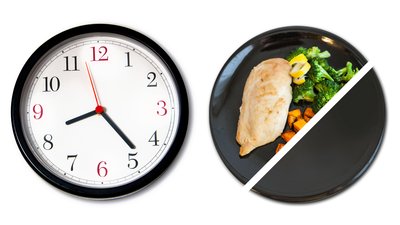In the fitness industry, more than just about any industry that comes to mind, extremes are the norm. What is the status quo today will be garbage tomorrow, and the opposite will become the status quo. I talked about this in my article "The Science of Sugar and Fat-Loss," but it applies to lifts and behaviors as well as nutrients.
Think about it: 10 years ago, bodybuilders shunned the big lifts of squat, bench, and deadlift. Now it seems like every uppity bodybuilder is using a DUP template for squat, bench, and deadlift. Not that there's a problem with that approach; I'm a fan of the big three lifts.
Eating schedules are definitely subject to these epic mood swings as well. A decade back, bodybuilder logic had everyone in the gym eating every 2-3 hours to "stoke the metabolic fire" and stay anabolic. Today, the gym is aflutter with talk about not eating for as long as 16-20 hours straight, what is known as "intermittent fasting."
Both of these camps have their diehard adherents, and I'm not here to say that one is always right or the other dead wrong. But let's investigate the logic behind both so we can figure out what will work best for you.
The Old Way: Eat, Eat, Eat
Let's start by looking at the old "eat every 2-3 hours" method, and in particular its claims about metabolic rate first. It has been proposed by countless experts over the years that eating more frequently will improve overall metabolic rate. While I'll admit that the logic initially sounds good, it does not seem to stand the litmus test of the scientific evidence.

Virtually every study examining meal frequency in a recent meta-analysis demonstrated zero differences in fat loss when calories were controlled. Surprisingly, there also do not appear to be differences in markers of hungers with changes in meal frequency, and metabolic rate was not affected by meal frequency.[1,2]
This may seem blasphemous to the devout followers of the 6-8-meals-per-day mantra, but it's difficult to argue with the data. However, it's worth noting that this is in regard to fat loss. When strength and muscle gains are the goal, three square meals a day may not provide enough protein distribution.
That's why, in my PH3 Power and Hypertrophy program, I advocate 4-5 protein-rich meals per day, depending on your personal preference. Any less, and you're going to be left cramming crazy amounts of protein into individual meals, which as I'll discuss a little later, also isn't a good idea.
The New Way: Fast, Then Feast
So if eight meals is off the table, it automatically means you should be doing intermittent fasting right? Maybe—but maybe not.
The most important factor for long-term success in dieting isn't when you eat; it's adherence. That's right: People don't fail diets because they don't have the perfect meal frequency, food sources, or magical voodoo cleanse; they fail diets because they simply cannot stick to them.
Research data shows that of the people who lose a significant amount of weight, the majority of them will regain the weight they originally lost, and after five years, they often exceed their initial weight.[3,4] This is a huge problem, and to solve it, the focus should be on utilizing strategies that improve dietary adherence.
Thus, if intermittent fasting allows a person to better fit a diet into their lifestyle and stick to that diet, that's a good enough argument for me—at least in regard to that person. I've known many people who were able to fast certain parts of the day, due to lack of hunger at those times, or simply because they had very busy jobs and that manner of eating fit their lifestyle better.

There's another advantage, of course. Spread, say, 2,500 calories over 6-8 meals, and you'll end up with some pretty paltry portions, but those same calories over 1-2 meals can make for a fantastic food celebration. Many people prefer to hold out a bit longer to have larger meals. I know that when I dropped from eight meals per day to four meals per day, I was much more satisfied, and my hunger levels dropped.
Can you take this too far? Of course. Many people find they simply can't go 12 hours or more without becoming ravenously hungry, and this may make them more likely to binge eat. For others with disordered eating tendencies, they may start getting loose with their feeding windows or hoarding food.
Here's what I mean: A normal intermittent-fasting protocol is typically 16 hours fasting with 8 hours feeding, give or take a few hours. But some people will slide into, say, 22/2, and I've even seen people go days without eating in order to justify and enormous binge. That is not a fault of intermittent fasting itself, but it definitely means that it is not an appropriate protocol for everyone. Thus, understanding your tendencies toward food and what you like is extremely important.
So if you prefer fasting, and it helps you be more adherent to a diet, then by all means do it. But keep in mind that it's not magic, and it can be done wrong. Fat loss is ultimately a question of calories, not clocks.
A Modified Fast For Max Muscle Growth
It's becoming clear that while your daily protein intake is important, so is how much you consume per meal and how those meals are distributed. But while most people use this realization only to argue for more protein per meal, there may be a point of diminishing returns that is important for intermittent fasters to take into account.
Research from our lab concluded that when it comes to optimizing muscle protein synthesis, overconsuming protein at one time of the day couldn't make up for low protein at another time of the day.[5] So just as there is a defined protein threshold to initiate anabolism, there also appears to be a maximal anabolic cap.[6,7] In action, this means that if you only eat a small amount of protein most of the day, but then you eat a ton of protein at one meal, it's not going to "balance out."

For example, let's pretend that this anabolic cap is 40 grams protein, and the minimum protein required to initiate anabolism is 15 grams—this is all theoretical, to be clear. Obviously, you wouldn't be anabolic during your 16-hour fast. But then, to get your 200 grams of protein in that eight-hour window at three meals, you could be consuming around 65 grams of protein at each meal. This is almost 50 percent over the theoretical anabolic cap.
For the average Joe just looking to lean up, this may not be a big deal. However, if you want some of the benefits from intermittent fasting but want to optimize muscle mass, I would advise a different type of fast. Rather than cutting out all calories, simply restrict carbs and fats during your fasting window, but continue to evenly distribute your protein intake throughout the day. Until we know where this possible anabolic cap is, this strikes me as more effective than trying to cram it all into your feeding "window."
Take this approach, and you are still going to get a large volume of food in the feeding period and spend a large portion of the day in a low-insulin fat-burning state, but you'll be able to distribute protein in such a way that is better for muscle growth.
References
- Schoenfeld, B. J., Aragon, A. A., & Krieger, J. W. (2015). Effects of meal frequency on weight loss and body composition: a meta-analysis. Nutrition Reviews, 73(2), 69-82.
- Cameron, J. D., Cyr, M. J., & Doucet, E. (2010). Increased meal frequency does not promote greater weight loss in subjects who were prescribed an 8-week equi-energetic energy-restricted diet. British Journal of Nutrition, 103(08), 1098-1101.
- Crawford, D., Jeffery, R. W., & French, S. A. (2000). Can anyone successfully control their weight? Findings of a three year community-based study of men and women. International Journal of Obesity & Related Metabolic Disorders, 24(9), 1107-1110.
- Dulloo, A. G., Jacquet, J., & Montani, J. P. (2012). How dieting makes some fatter: from a perspective of human body composition autoregulation. Proceedings of the Nutrition Society, 71(03), 379-389.
- Norton, L. E., Wilson, G. J., Layman, D. K., Moulton, C. J., & Garlick, P. J. (2012). Protein distribution affects muscle mass based on differences in postprandial muscle protein synthesis and plasma leucine in rats. Nutrition, 9(1), P23.
- Norton, L. E., Wilson, G. J., Layman, D. K., Moulton, C. J., & Garlick, P. J. (2012). Leucine content of dietary proteins is a determinant of postprandial skeletal muscle protein synthesis in adult rats. Nutrition & Metabolism, 9(1), 1.
- Moore, D. R., Robinson, M. J., Fry, J. L., Tang, J. E., Glover, E. I., Wilkinson, S. B., ... & Phillips, S. M. (2009). Ingested protein dose response of muscle and albumin protein synthesis after resistance exercise in young men. The American Journal of Clinical Nutrition, 89(1), 161-168.


